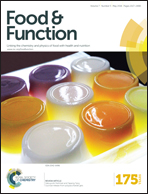Black tea polyphenols and polysaccharides improve body composition, increase fecal fatty acid, and regulate fat metabolism in high-fat diet-induced obese rats†
Abstract
With the current changes in diet and living habits, obesity has become a global health problem. Thus, the weight-reducing function of tea has attracted considerable attention. This study investigated the anti-obesity effect and the mechanism of black tea (BT) polyphenols and polysaccharides in male Sprague-Dawley rats. The BT polyphenols and polysaccharides reduced the body weight, Lee's index, visceral fat weight, and fat cell size but improved the biochemical profile and increased the fecal fatty acid content, thereby preventing high-fat diet-induced obesity. A gene expression profile array was used to screen eight upregulated and five downregulated differentially expressed genes that affect fat metabolic pathways, such as glycerolipid and glycerophospholipid metabolism, fatty acid degradation, glycolysis and gluconeogenesis, bile and pancreatic secretion, the insulin signaling pathway, and steroid hormone secretion. The BT polyphenols and polysaccharides suppressed the formation and accumulation of fat and promoted its decomposition to prevent obesity.


 Please wait while we load your content...
Please wait while we load your content...